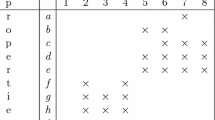Abstract
Fuzzy clustering algorithms are able to find the centroids and partition matrices, but are predominantly numerical, although each cluster prototype can be considered as a granule of information it continues to be a numeric value, in order to give a similar representation structure data. Granular theory and clustering algorithms can be combined to achieve this goal, resulting in granular prototypes and granular matrices of belonging and a more reflective data structure.
Access this chapter
Tax calculation will be finalised at checkout
Purchases are for personal use only
Similar content being viewed by others
References
Bargiela, A., Pedrycz, W., Hirota, K.: Granular prototyping in fuzzy clustering. IEEE Trans. Fuzzy Syst. 12(5), 697–709 (2004)
Bezdek, J.: Pattern Recognition with Fuzzy Objective Function Algorithms. Plenum, Berlin (1981)
Chang, X., Li, W., Farrell, J: A C-means clustering based fuzzy modeling method. In: The Ninth IEEE International Conference on Fuzzy Systems, 2000. FUZZ IEEE 2000, vol. 2, pp. 937–940 (2000)
Gacek, A.: From clustering to granular clustering: a granular representation of data in pattern recognition and system modeling. In: IFSA World Congress and NAFIPS Annual Meeting (IFSA/NAFIPS), 2013 Joint, pp. 502–506, 24–28 June 2013
Gustafson, D.E., Kessel, W.C.: Fuzzy clustering with a fuzzy covariance matrix. In: Proceedings of IEEE Conference on Decision and Control, San Diego, CA, pp. 761–766 (1979)
Hirota, K., Pedrycz, W.: Fuzzy computing for data mining. Proc. IEEE 87(9), 1575–1600 (1999)
Hwang, C., Rhee, F.: Uncertain fuzzy clustering: interval type-2 fuzzy approach to C-means. IEEE Trans. Fuzzy Syst. 15(1), 107–120 (2007)
Iyer, N.S., Kendel, A., Schneider, M.: Feature-based fuzzy classification for interpretation of mamograms. Fuzzy Sets Syst. 114, 271–280 (2000)
Karnik, N., Mendel, J.: Operations on type-2 set. Fuzzy Set Syst. 122, 327–348 (2001)
Krishnapuram, R., Keller, J.: A possibilistic approach to clustering. IEEE Trans. Fuzzy Syst. 1(2), 98–110 (1993)
Krishnapuram, R., Keller, J.: The possibilistic c-Means algorithm: Insights and recommendations. IEEE Trans. Fuzzy Sys. 4(3), 385–393 (1996)
Kruse, R., Döring, C., Lesot, M.J.: Fundamentals of fuzzy clustering. In: Advances in Fuzzy Clustering and its Applications. Wiley, Chichester, pp. 3–30 (2007)
Mendel, J.: Uncertain Rule-Based Fuzzy Logic Systems: Introduction and New Directions, pp. 213–231. Prentice-Hall, Englewood Cliffs (2001)
Pal, N.R., Pal, K., Keller, J.M., Bezdek, J.: A possibilistic fuzzy c-means clustering algorithm. IEEE Trans. Fuzzy Syst. 13(4), 517–530 (2005)
Pedrycz, W., Bargiela, A.: An Optimization of allocation of information granularity in the interpretation of data structures: toward granular fuzzy clustering. IEEE Trans. Syst. Man Cybern. B Cybern 42(3), 582–590 (2012)
Philips, W.E., Velthuinzen, R.P., Phuphanich, S., Hall, L.O., Clark, L.P., Sibiger, M.L.: Application of fuzzy c-means segmentation technique for tissue differentiation in MR images of hemorrhagic glioblastoma multiforme. Magn. Reson. Imaging 13(2), 277–290 (1995)
Rubio, E., Castillo, O.: Interval type-2 fuzzy clustering for membership function generation. In: IEEE Workshop on Hybrid Intelligent Models and Applications (HIMA), pp. 13–18, 16–19 Apr 2013
Yang, M.-S., Hu, Y.-J., Lin, K.C.-R., Lin, C.C.-L.: Segmentation techniques for tissue differentiation in MRI of Ophthalmology using fuzzy clustering algorithms. Magn. Reson. Imaging 20, 173–179 (2002)
Zarandi, M.H.F., Zarinbal, M., Türksen, I.B.: Type-II fuzzy possibilistic C-mean clustering. In: IFSA/EUSFLAT Conference, pp. 30–35 (2009)
Author information
Authors and Affiliations
Corresponding author
Editor information
Editors and Affiliations
Rights and permissions
Copyright information
© 2015 Springer International Publishing Switzerland
About this chapter
Cite this chapter
Rubio, E., Castillo, O. (2015). A New Proposal for a Granular Fuzzy C-Means Algorithm. In: Melin, P., Castillo, O., Kacprzyk, J. (eds) Design of Intelligent Systems Based on Fuzzy Logic, Neural Networks and Nature-Inspired Optimization. Studies in Computational Intelligence, vol 601. Springer, Cham. https://doi.org/10.1007/978-3-319-17747-2_4
Download citation
DOI: https://doi.org/10.1007/978-3-319-17747-2_4
Published:
Publisher Name: Springer, Cham
Print ISBN: 978-3-319-17746-5
Online ISBN: 978-3-319-17747-2
eBook Packages: EngineeringEngineering (R0)




